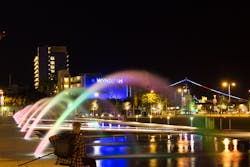Building Amenities: A Critical Piece of the Sustainability Puzzle
It is no secret that ecologically sound buildings have gained momentum over the years as owners increasingly emphasize sustainability at their properties.
This emphasis highlights the value of energy efficiency for many commercial property professionals, especially facility owners and managers.
However, what many have neglected is the sustainability focus on one very important building aspect: amenities. The truth is the right amenities can make a tremendous difference in a property’s ability to achieve energy savings. In addition to boosting the value and aesthetic appeal of buildings, features that are designed and constructed with sustainability in mind are ideally positioned to help stakeholders reach these goals now and well into the future.
As a design/build firm that focuses on creating water features, rockwork and themed environments for the built environment, OTL has seen the positive impact these amenities have on accomplishing sustainability initiatives. Here are some of the ways that water features can accelerate the achievement of environmentally friendly objectives.
Water Conservation
Many owners and facility managers are surprised to learn that water features can actually help them conserve water at their buildings.
Proper design diminishes evaporation and splash, which are the primary means through which water in commercial fountains is lost. In addition, using recirculated water to run fountains enhances conservation efforts, which is demonstrated by the water feature project our firm completed at downtown San Diego’s Waterfront Park. An underground reservoir is utilized to store the approximately 80,000 gallons of water required to operate this amenity; there, the water is continually filtered and recirculated, providing the city with an asset that is not only safe and sanitary, but also sustainable.
Additional alternative water sources fountains can employ that are also ecologically friendly include recycled water, reclaimed stormwater and HVAC condensate—proving that just because an amenity uses water doesn’t mean it has to waste this precious resource. In fact, despite beliefs to the contrary, well-designed, engineered, constructed and maintained water features do not waste water or function on a high amount of water. Also, fountains actually encourage the people who experience them and are moved by their beauty to conserve water as they go about their day—which has a positive ripple effect on the environment.
Utility Load Reduction
Water features at commercial properties can provide a unique dual benefit: they can be combined with building systems to reduce the load on utilities used for air conditioning, which furthers sustainability at these assets while saving stakeholders money. This can add up to significant ecological benefits along with cost control, especially in warmer climates where energy grids may be strained by excess cooling-system use.
Reduction in energy usage is obtained by integrating atrium and interior fountains into a property’s environmental system, which can be designed to lower relative humidity inside the building and decrease the need to turn up the air conditioning.
Outdoor fountains can also provide a benefit if designed with this in mind. When connected to a building’s mechanical system, the water systems functions as a heatsink for HVAC equipment, operating like a cooling tower to deliver a passive heat exchanger that reduces the demand for air conditioning. We have seen buildings in hot climates experience notable decreases in their utility bills by taking advantage of this connection.
Technology That Minimizes Waste
Modern water feature technology enables property owners and managers to monitor water feature equipment so they are notified before they waste resources or cause property damage.
Our company employs systems that allow water features to be managed off-site and can send immediate alerts to building operators if a problem is detected. This technology can also shut down a fountain immediately in an emergency to minimize any negative impact on the property.
Other technological features such as programmable logic controllers, variable frequency drive pumps and LED lights decrease overall energy use, delivering additional sustainability and cost benefits for stakeholders.
Water feature technology is ever-evolving, providing new operational efficiencies and advantages to installing these amenities at commercial properties.
Conclusion
As research continues to support the need for more efficient building practices, savvy building owners and operators are increasingly seeking amenities that align with their sustainability goals. By helping to conserve water, reduce energy use, and minimize waste, today’s water features make the ideal amenity to assist building professionals in achieving those goals.
About the Author
Tom Real
Tom Real is the Vice President of Engineering and Preconstruction at OTL, a design-build themed construction company that specializes in creating one-of-a-kind rockwork, water features and themed environments for retail entertainment, hospitality, gaming, and golf properties around the globe.
